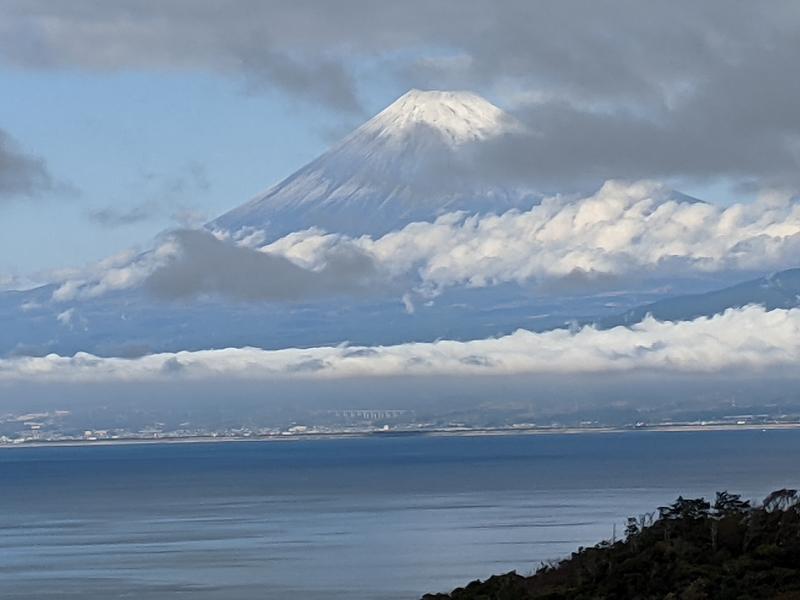Today, after a one week test, I returned the Hyundai Ioniq 5.
Yesterday I did an extended test drive to one of my favourite parts of Japan, the Izu peninsula. I often go there for bike rides to take pictures. This time I drove over 440 km, which is pretty long for any drive I do. My longest drive this year until now had been 310 km.
I had a great day. It was a perfect day to enjoy Mt Fuji views and ocean views in Izu and the Ioniq 5 was a great car to do it in, more about that below.
The two concerns that keep people off opting for EVs when buying cars are range anxiety and cost. Izu is not the most well served part of Japan, as far as charging is concerned, and yet I really didn’t have to worry. Even when starting from Tokyo with a battery only charged to around 75% of its capacity, I came back with 30% of charge left after only a quick charge while having a 25 minute coffee and snack break. I charged at a 50 kW fast charger at a Familymart convenience store in Matsuzaki to at least once try out public chargers (previously I only tested charging at home) and it added about 150 km of range in a little over 20 minutes. Given a fast enough charger, the Ioniq can actually charge 5 times faster than that.
I later passed a 180 kW charger, but didn’t use it because I had plenty of battery left to get home and drop off the car tomorrow. Given a suitable charger (e.g. 350 kW), the current model of Ioniq 5 can charge at up to 260 kW, but the fastest chargers available in Japan right now are 220 kW.
On cost, the Ioniq is quite reasonable, when compared to brands such as Audi, Mercedes or Volvo. There are EV subsidies available from the national government and prefectural governments (e.g. Tokyo). Long term, there are substantial savings from the cost of electricity vs. gasoline, especially if you have solar panels on the roof and can generate your own power. A hybrid that gets 18 km/l at 160 yen/liter costs 9 yen/km. A non-hybrid ICE could be double that. An EV that consumes 180 Wh/km at 15 yen/kWh (Tepco FIT rate) costs 2.7 yen/km. At 40 yen/kWh from the standard grid without low cost night time tariff it costs 7 yen/km. That and no annual oil changes, no new spark plugs, etc.
One huge difference between electric cars (BEV) and internal combustion engine cars (ICE) is noise. When you put the foot down, both more or less do the job, but one does it without any fuss at all while the other becomes noisy. The Ioniq impressed me by just how quiet it was throughout (which is an excellent basis for enjoying the Bose speakers that come standard in the Lounge version). Whether you’re taking it easy or pushing the car hard, it just does it quietly, except for a minimal amount of tyre rumble and wind noise. That makes for a very relaxed experience. I don’t think I ever came back from a 13 hour drive feeling as fresh as I did today.
I also loved both the suspension and the seats. The ride is neither too soft nor too hard and the seats stayed comfortable and supportive at all times.
This is a great long distance car. It does everything my 2013 Toyota Prius did, only better and without burning fossil fuels (if you charge it with renewable energy, whose share will only keep increasing from now).
If I had to pick anything I didn’t like, I can only mention the digital rear view mirror (which thankfully can be switched to analog). It’s an LCD monitor in place of the usual center mirror, hooked up to a camera at the back of the car. Every time I looked at it, my eyes had to refocus from objects far away as seen through the windscreen to a monitor only 30 cm from my eyes, resulting in fuzzy recognition for a fraction of a second. Analog rear view mirrors don’t have that issue, as they don’t force your eyes to refocus.
I realize that the Ioniq is too large or too expensive for a lot of people, but the Hyundai Kona and Hyundai Inster are also very capable cars that are smaller and cheaper while using much of the same technology.
After returning the Ioniq 5, I placed an order to buy one. It will arrive next month.







